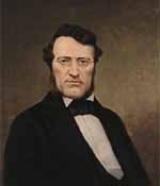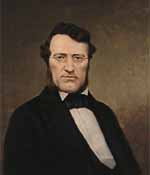
George Harvey
Encyclopedia

Scotland
Scotland is a country that is part of the United Kingdom. Occupying the northern third of the island of Great Britain, it shares a border with England to the south and is bounded by the North Sea to the east, the Atlantic Ocean to the north and west, and the North Channel and Irish Sea to the...
painter, the son of a watchmaker
Watchmaker
A watchmaker is an artisan who makes and repairs watches. Since virtually all watches are now factory made, most modern watchmakers solely repair watches. However, originally they were master craftsmen who built watches, including all their parts, by hand...
, was born at St Ninians, near Stirling
Stirling
Stirling is a city and former ancient burgh in Scotland, and is at the heart of the wider Stirling council area. The city is clustered around a large fortress and medieval old-town beside the River Forth...
.
Soon after his birth his parents removed to Stirling, where George was apprenticed to a bookseller. His love for art having, however, become very decided, in his eighteenth year he entered the Trustees' Academy at Edinburgh
Edinburgh
Edinburgh is the capital city of Scotland, the second largest city in Scotland, and the eighth most populous in the United Kingdom. The City of Edinburgh Council governs one of Scotland's 32 local government council areas. The council area includes urban Edinburgh and a rural area...
. Here he so distinguished himself that in 1826 he was invited by the Scottish artists, who had resolved to found a Scottish academy, to join it as an associate (see Royal Scottish Academy
Royal Scottish Academy
The Royal Scottish Academy is a Scottish organisation that promotes contemporary Scottish art. Founded in 1826, as the Royal Institution for the Encouragement of the Fine Arts, the RSA maintains a unique position in Scotland as an independently funded institution led by eminent artists and...
).
Harvey's first picture, "A Village School," was exhibited in 1826 at the Edinburgh Institution; and from the time of the opening of the Academy in the following year he continued annually to exhibit. His best-known pictures are those depicting historical episodes in religious history from a puritan or evangelical point of view, such as "Covenanters' Preaching," "Covenanters' Communion," "John Bunyan
John Bunyan
John Bunyan was an English Christian writer and preacher, famous for writing The Pilgrim's Progress. Though he was a Reformed Baptist, in the Church of England he is remembered with a Lesser Festival on 30 August, and on the liturgical calendar of the Episcopal Church on 29 August.-Life:In 1628,...
and his Blind Daughter," "Sabbath Evening," and the "Quitting of the Manse."
He was, however, equally popular in Scotland for subjects not directly religious; and "The Bowlers," "A Highland Funeral," "The Curlers," "A Schule Skailin'," and "Children Blowing Bubbles in the Church-yard of Greyfriars', Edinburgh," manifest the same close observation of character, artistic conception and conscientious elaboration of details. In "The Night Mail" and "Dawn Revealing the New World to Columbus" the aspects of nature are, made use of in different ways, but with equal happiness, to lend impressiveness and solemnity to human concerns. He also painted landscapes and portraits.
In 1829 he was elected a fellow of the Royal Scottish Academy; in 1864 he succeeded Sir JW Gordon
John Watson Gordon
Sir John Watson Gordon was a Scottish portrait painter and a president of the Royal Scottish Academy.-Life and work:He was born John Watson in Edinburgh, the eldest son of Captain Watson, R.N., a cadet of the family of Watson of Overmains, in the county of Berwick. He was educated specially with a...
as president; and he was knighted in 1867. He died at 21 Regent Terrace
Regent Terrace
Regent Terrace is a residential street of 34 classical 3-bay townhouses built on the tail of Calton Hill in the city of Edinburgh, Scotland. Regent Terrace is within the Edinburgh New and Old Town UNESCO World Heritage Site inscribed in 1995.- Houses :...
in Edinburgh on the 22nd of January 1876.
Sir George Harvey was the author of a paper on the "Colour of the Atmosphere," read before the Edinburgh Royal Society, and afterwards published with illustrations in Good Words; and in 1870 he published a small volume entitled Notes of the Early History of the Royal Scottish Academy. Selections from the Works of Sir George Harvey, PRSA, described by the Rev. AL Simpson, FSA Scot., and photographed by Thomas Annan, appeared at Edinburgh in 1869.

